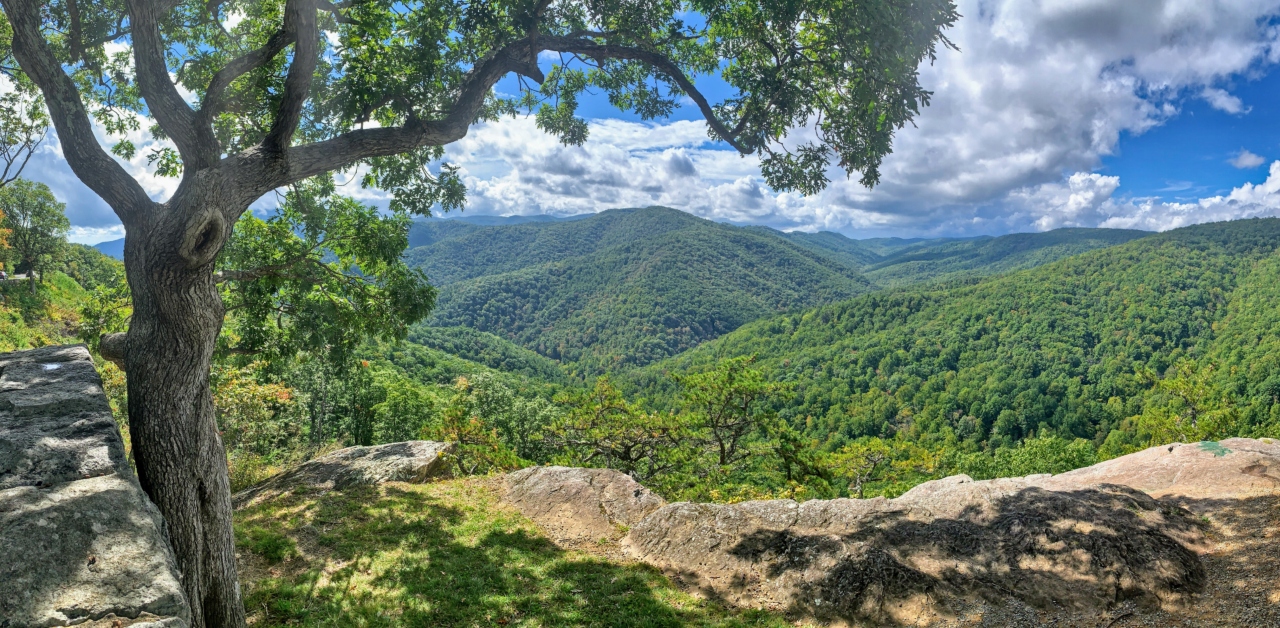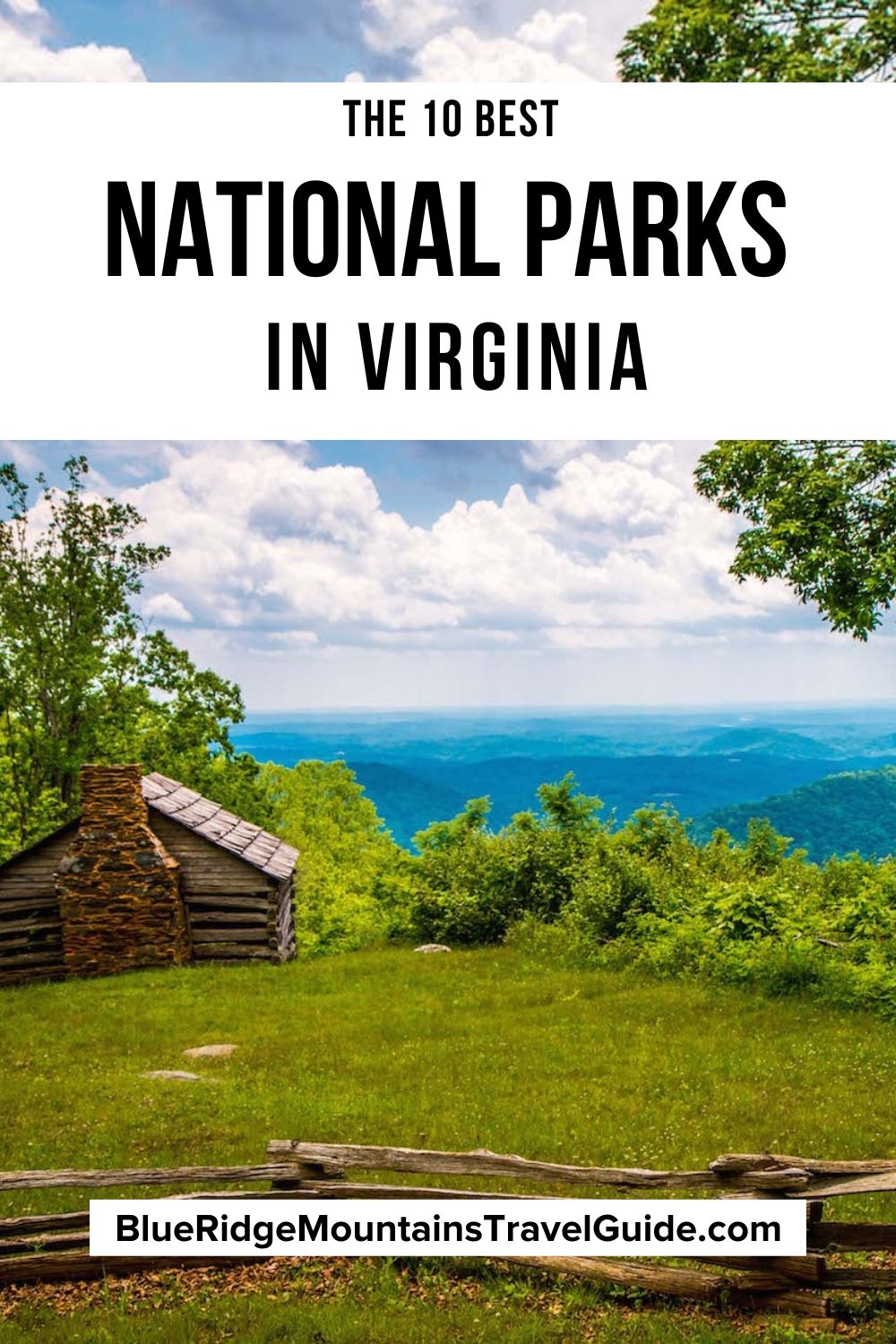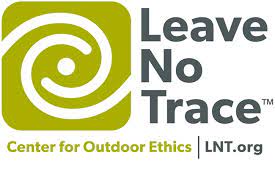Virginia is for lovers, but it’s easy to love because the state is blessed with an abundance of natural beauty.
Visitors are constantly wowed by the state’s diverse landscapes, from the Grayson Highlands, Shenandoah Valley, and Blue Ridge Mountains to the beautiful Virginia coastline and barrier islands.
The state is also full of rich American culture and history, which is often anchored to stunning wild places such as Harpers Ferry and the Cumberland Gap.
Virginia is also home to the first British colonies in the Americas, and surrounds the nation’s capital of Washington, D.C.
With this riveting combination of wilderness and history, it’s no wonder that Virginia’s national parks are so popular. Even the Virginia state parks are award-worthy!
But if you’re looking to explore the best parks in Virginia, in our experience the national parks in Virginia are the biggest show-stoppers.
Read on for our in-depth guide to the best National Parks in VA, which includes a nice mixture of nature, history, culture, mountains, beaches, hiking trails, and more.
READ MORE: 20 Things to Do in the Blue Ridge Mountains of Virginia
Best National Parks in Virginia Guide
(Arranged Alphabetically)
- Appalachian Trail
- Assateague Island National Seashore
- Blue Ridge Parkway
- Booker T. Washington National Monument
- Colonial National Historic Park
- Cumberland Gap National Historic Park
- George Washington Birthplace National Monument
- Great Falls Park
- Harpers Ferry National Historic Park
- Shenandoah National Park
READ MORE: The 10 Best Things to Do in Bristol TN/VA
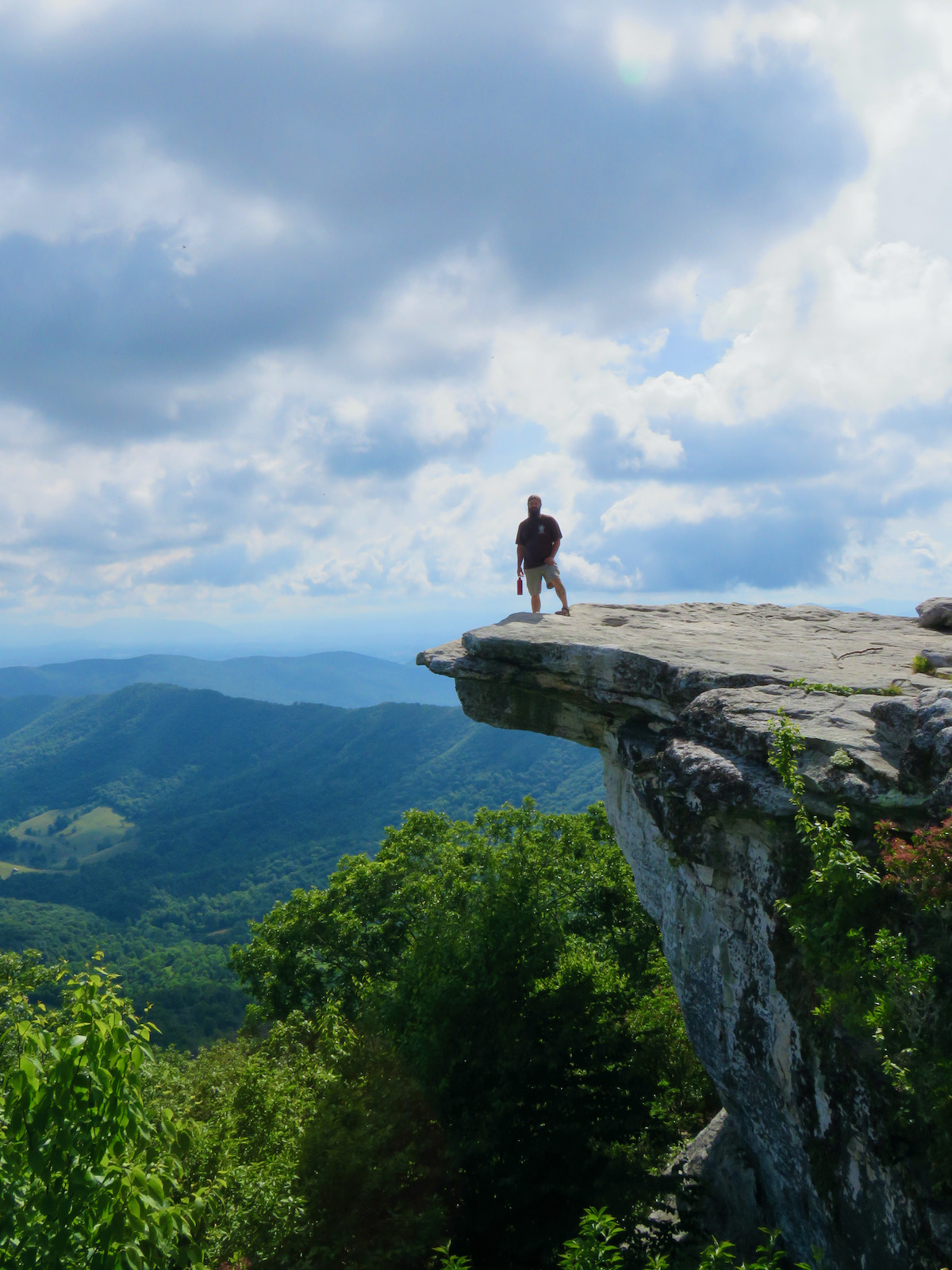
1. The Appalachian Trail
The state of Virginia is home to more miles of the Appalachian Trail than any of the other 13 states the AT traverses. At 541.7 miles, nearly a quarter of the famous hiking path is in Virginia.
The Appalachian Trail in Virginia enters from Tennessee (near Damascus) and exits at Harpers Ferry.
It climbs to over 5,500 feet on Mt. Rogers (VA’s highest peak) and descends to 265 feet, one of the lowest points on the AT.
There are several great options for day hikes on the Appalachian Trail in VA.
Some of the top treks include McAfee Knob hike near Roanoke (my favorite), Blackrock Summit in Shenandoah National Park, and the waterfall-laden route from Crabtree Falls to The Priest.
The AT in Virginia passes through George Washington & Jefferson National Forest, Shenandoah National Park, and Harpers Ferry National Historic Park.
In addition to vast wilderness, the Virginia AT passes by mountain towns like Marion and Luray, as well as more developed destinations like Roanoke and Harrisonburg.
READ MORE: The 10 Best Things to Do in Staunton VA

2. Assateague Island National Seashore
Located on the Atlantic in both Maryland and Virginia, Assateague Island National Seashore is on a barrier island. Assateague State Park is in Maryland, while Chincoteague National Wildlife Refuge is in Virginia.
The Virginia District of AINS is only accessible by car from the Virginia side, and vice versa for Maryland. In other words, it isn’t possible to drive the entire length of the island, which remains a very wild place.
There is a Visitors Center on the mainland, before you cross the bridge to the park, and it is definitely worthy of making a stop to learn more about the National Park.
Assateague Island’s campgrounds have 148 campsites, some of which are oceanside while others overlook the bay. There are also 3 short hiking trails, beaches for swimming, and an over-sand vehicle zone.
Kayaking, fishing, and crabbing are also popular here. Wildlife is abundant in the park, including Ghost Crabs, Red Foxes, and introduced Sika Deer.
Marine mammals such as Dolphins are also commonly sighted here, but the famous Wild Horses of Assateague Island are likely the most popular animal sighting in the park.
READ MORE: The 10 Best Campgrounds in Virginia
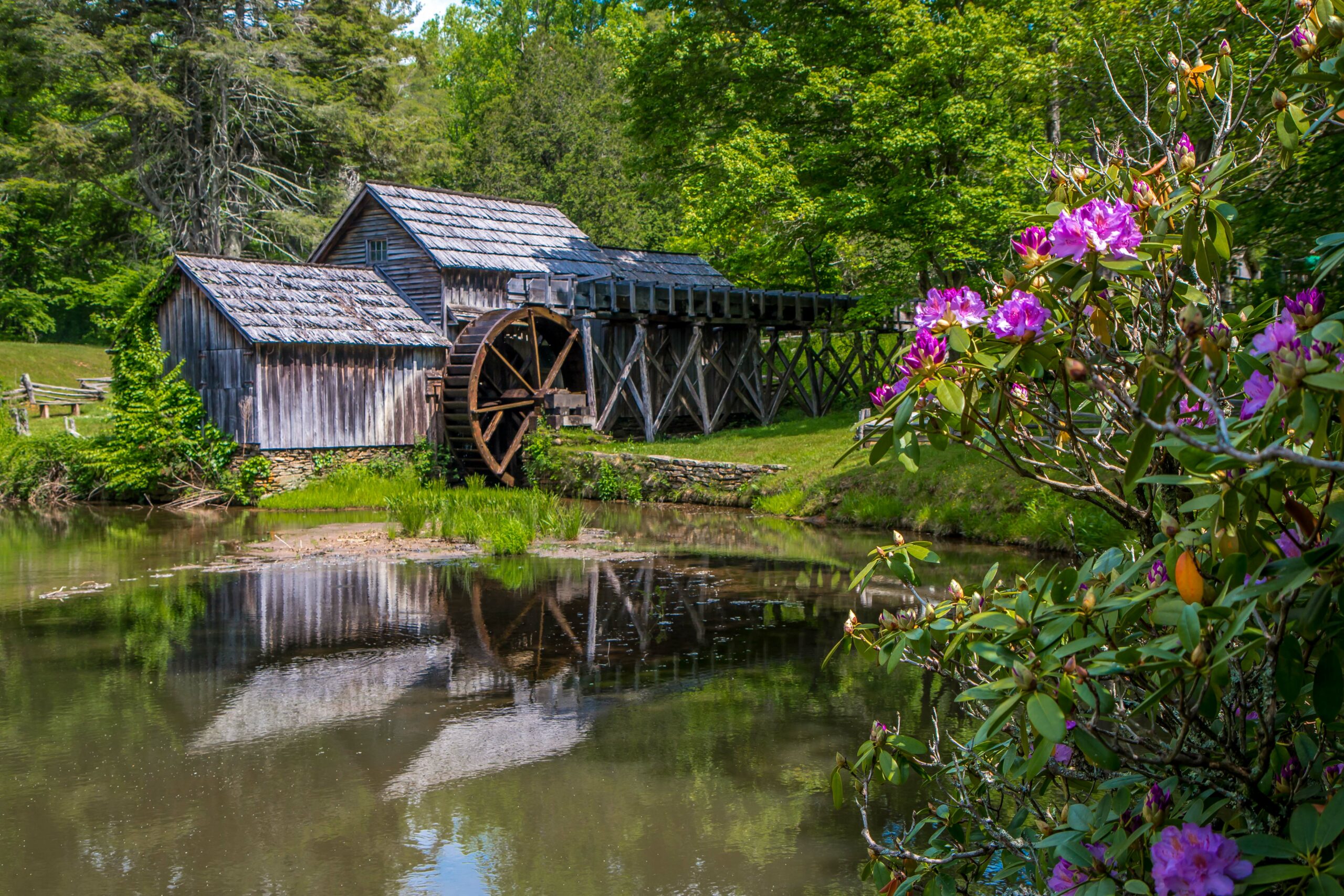
3. Blue Ridge Parkway
The world-renowned Blue Ridge Parkway stretches some 469 miles, which is shared in roughly even portions between North Carolina and Virginia.
This scenic route connects Great Smoky Mountains National Park and Shenandoah National Park. And with 15+ million visitors a year, the Parkway is the most visited unit of the U.S. National Park system.
It is the widely regarded as the country’s premier scenic roadway, offering expansive views of the Appalachian Mountains and Piedmont, as well as amazing spring wildflowers and fall foliage.
Some of the more popular Blue Ridge Parkway overlooks in Virginia include the Groundhog Meadow Overlook, Mabry Mill, Raven’s Roost Overlook, and the Peaks of Otter.
The BRP also weaves by numerous notable Virginia mountain towns such as Galax, Roanoke, and Lexington & Natural Bridge.
It also has attractions like the Blue Ridge Music Center, which features Bluegrass and other forms of Appalachian Music.
READ MORE: The 15 Best Blue Ridge Parkway Hotels & Cabin Rentals in NC & VA

4. Booker T. Washington National Monument
Born into enslavement in 1856, Booker T. Washington ultimately became an influential U.S. leader, respected advisor, widely read author, and famed orator.
Located just a few miles west of Smith Mountain Lake, the Booker T. Washington National Monument preserves the 207-acre farm upon which he was born.
The park has a Visitor Center that features exhibits and an audio-visual presentation about the influential life of Booker T. Washington, and African-American history on the whole.
Visitors can also explore the Plantation Trail, a 1/4-mile loop through the farm, and the Jack-O-Lantern Branch Heritage Trai, which travels 1.5 miles through the forest and fields.
There’s also a picnic area, a petting farm with animals, and a lovely garden area that is representative of what would have been grown in 1850s Virginia.
READ MORE: The 10 Best Restaurants in Roanoke VA

5. Colonial National Historic Park
Virginia’s Colonial National Historic Park offers an in-depth look at U.S. history through the lens of its early European settlers.
This park includes Historic Jamestown, the Yorktown Battlefield, and the 23-mile Colonial Parkway (which connects the York and James Rivers).
In 1607, Jamestown became the first permanent English settlement in the New World. By 1619, slavery was growing popular, so three cultures—Native Americans, English, and African—were represented there.
The Yorktown Battlefield was home to the last major Revolutionary War battle in 1781. General George Washington led American and French forces against General Cornwallis and the British army.
Running between the York and James Rivers (and passing through Williamsburg in the process), the Colonial Parkway links these amazing historic sites as well as featuring beautiful wild scenery.
READ MORE: The 10 Best Historic & Covered Bridges in Virginia

6. Cumberland Gap National Historic Park
Known as the “Gateway to the West,” the Cumberland Gap was the route colonialists used to move beyond the seemingly impassable Appalachian Mountains.
This National Park straddles three states– Kentucky, Tennessee, and Virginia.
Long before Daniel Boone and the pioneers found their way through the Cumberland Gap, Native Americans were using it as a pass through the Virginia mountains.
It took European settlers nearly a 150 years to find a route to the other side of the Appalachian range.
Cumberland Gap National Historic Park has buildings used by these early pioneers, who were often attacked by Native Americans unhappy about being displaced. There are also ruins of various Civil War forts.
Other popular features at the park include ranger-led Gap Cave tours, ancient geological formations, over 80 miles of hiking trails, and tons of wildlife.
READ MORE: The 10 Best Caves and Caverns in Virginia

7. George Washington Birthplace National Monument
George Washington was born in the Northern Neck of Virginia on February 22, 1732. He grew up on Popes Creek Plantation, which was built by his father in the 1720s.
His original birth date on the Julian calendar was actually February 11, 1731, but it was moved in 1752 with the U.S. adoption of the Gregorian calendar.
The George Washington Birthplace National Monument encompasses 551 acres of the plantation, including historical buildings, the Colonial Revival Farm, and the Washington Family Burial Ground.
In addition to Washington’s history and a great Visitor Center, this national park also has plenty of natural beauty to enjoy, including picnic grounds and a public beach.
There’s also a Nature Trail and the Dancing Marsh Loop Trail for walking, and the roads are open to cyclists.
READ MORE: 10 Best Virginia Mountain Towns to Visit

8. Great Falls Park National Park
This 800-acre National Park near Washington, D.C. offers an absolutely gorgeous collection of waterfalls. Its cascades are formed as the Potomac River pushes through the narrow pass at Mathers Gorge.
The most popular thing to do at Great Falls National Park is to visit the waterfall overlooks, which are located near the visitor center and parking areas. The visitor center has trail maps, museum exhibits, and a film.
Other things to check out at Great Falls include 15 miles of hiking trails and 5 miles of trails for cycling. It’s a great spot to watch for the beautiful birds of Virginia.
Fishing is permitted with a license, and boating and climbing are options for experienced, equipped folks.
Picnicking is possible for all, but be prepared for waits on weekends and holidays. This park is extremely popular, as it is such an easy day trip from nearby cities.
Still, I never turn down the chance to see a top-flight waterfall, and Great Falls is world-class!
READ MORE: The 15 Best Virginia Waterfalls for Hiking
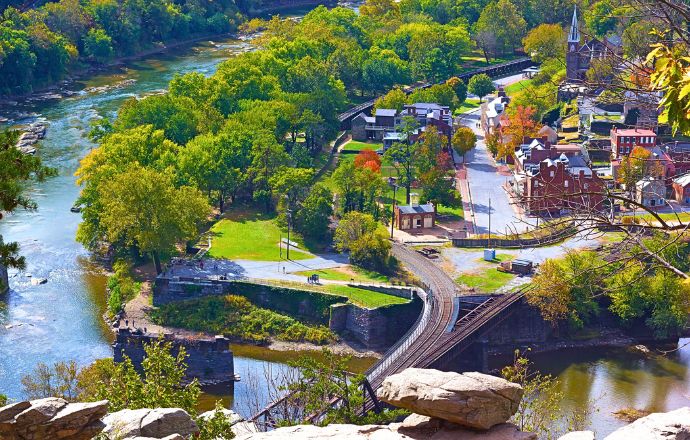
9. Harpers Ferry National Historic Park
Harpers Ferry National Historic Park has a gluttony of cultural significance, as well as some pretty remarkable natural splendor.
It sprawls across three states— Maryland, Virginia, and West Virginia—and is located at the confluence of the Shenandoah and Potomac Rivers.
Harpers Ferry attractions include the ever-popular Lower Town, which gets very crowded on peak days. The point overlooking the confluence of rivers is amazing, and the Appalachian Trail passes through the park.
The Civil Rights movement has deep roots here, too: Harpers Ferry was a major Civil War battleground.
Abolitionist John Brown and his raiders made their last stand at a fort in Harpers Ferry, and Storer College was (ahead of its time) open to all races and genders.
This park is extremely popular for good reason, but as a result it requires some patience and preparation. It’s always a good idea to have back-up plans, just in case the most popular parts are too crowded!
READ MORE: The 10 Best Civil War Battlefields in Virginia to Visit
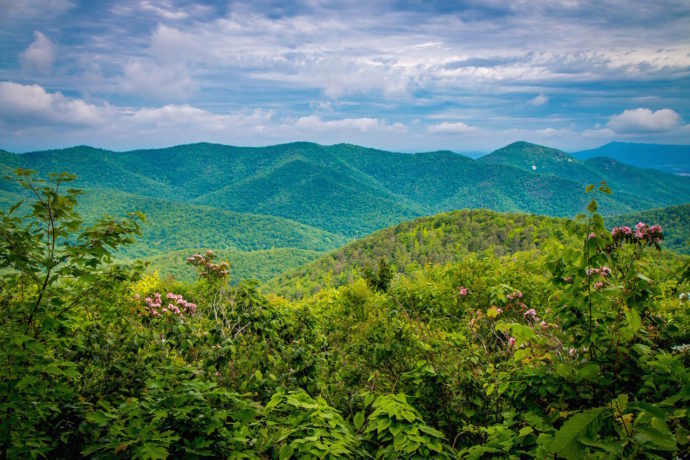
10. Shenandoah National Park
Located about 75 miles southwest of Washington, D.C. Shenandoah National Park is wilderness at its most beautiful. It’s full of amazing views, magical waterfalls, incredible flora, and tons of quiet spaces.
Much like the Blue Ridge Parkway, Skyline Drive in Shenandoah National Park is a beautiful stretch of scenic road with myriad overlooks, easy-access hikes, and special points of interest.
Along its route are the Dickey Ridge Visitor Center, the Big Meadows/Byrd Visitor Center, Skyland Lodge, and the Rapidan Camp.
There are also over 500 miles of hiking trails in Shenandoah National Park! There are some amazing short hikes under 2 miles, like the Blackrock Summit and Dark Hollow Falls.
Medium-length hikes in Shenandoah National Park include routes to Jones Run Falls, Lewis Falls, South River Falls, Doyles River Falls, and Chimney Rock.
Camping and cabins are a huge part of making the most of Shenandoah National Park.
It has some awesome historic lodges, and many locations perfect for spending a night or two in the wild. –by Jonathon Engels; featured photo of the 20-Minute Cliff BRP Overlook by Bret Love & Mary Gabbett

